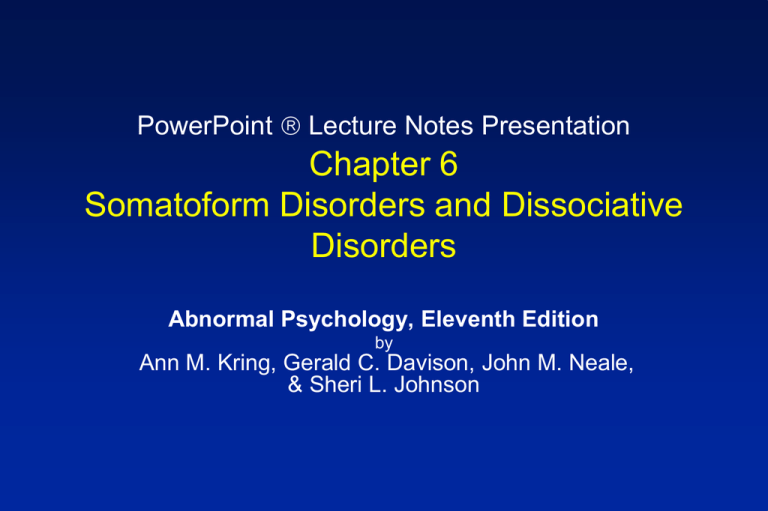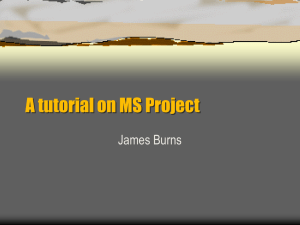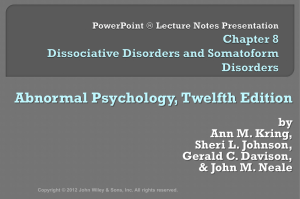
PowerPoint Lecture Notes Presentation
Chapter 6
Somatoform Disorders and Dissociative
Disorders
Abnormal Psychology, Eleventh Edition
by
Ann M. Kring, Gerald C. Davison, John M. Neale,
& Sheri L. Johnson
Dissociative Disorders
Sudden disruption in the continuity of:
» Consciousness
» Memory
» Identity
Dissociation
» Some aspect of cognition or experience
becomes inaccessible to consciousness
– Avoidance response
Copyright 2009 John Wiley & Sons, NY
2
Table 6.1 Summary of Dissociative
Disorders
Copyright 2009 John Wiley & Sons, NY
3
Dissociative Amnesia
Inability to recall important personal
information
» Usually about a traumatic experience
» Not ordinary forgetting
» Not due to physical injury
» May last hours or years
Usually remits spontaneously
» Memory returns in bits and pieces
Copyright 2009 John Wiley & Sons, NY
4
Dissociative Amnesia
DSM-IV-TR criteria
» One or more episode of inability to
remember important personal information,
usually of a traumatic event, that is too
extensive to be ordinary forgetting.
» Amnesia occurs outside of other
dissociative disorders, PTSD or acute
stress disorder, or somatization disorder,
and is not explained by other medical or
psychological conditions.
Copyright 2009 John Wiley & Sons, NY
5
Memory Deficits and Dissociation
Memory research shows the recall of trauma
is usually enhanced memory for central
events.
» High levels of stress hormones could interfere with
memory formation (Andreano & Cahill, 2006)
Copyright 2009 John Wiley & Sons, NY
6
Memory Deficits and Dissociation
Memory deficits in explicit but not implicit
memory
Explicit memory
» Involves conscious recall of experiences
– e.g., senior prom, mom’s birthday party
Implicit memory
» Underlies behaviors based on experiences that
cannot be consciously recalled
– e.g., playing tennis, writing a check
Copyright 2009 John Wiley & Sons, NY
7
Memory Deficits and Dissociation
Distinguishing other causes of memory loss
from dissociation:
» Degenerative brain disorders
–
–
–
–
e.g., Alzheimer's Disease
Not linked to stress
Involves gradual decline over time
Accompanied by other cognitive deficits
Inability to learn new information
» Substance abuse
– Linked to use of drug or alcohol
Copyright 2009 John Wiley & Sons, NY
8
Dissociative Fugue
Amnesia plus flight
» Latin fugere, “to flee”
Sudden, unexpected travel with inability
to recall one’s past
» Assume new identity
– May involve new name, job, personality
characteristics
» More often of brief duration
» Remits spontaneously
Copyright 2009 John Wiley & Sons, NY
9
Dissociative Fugue
DSM-IV-TR criteria
» Sudden, unexpected travel away from
home or work
» Inability to recall one’s past
» Confusion about identity or assumption of
new identity
» Symptoms are not explained by another
medical or psychological disorder
Copyright 2009 John Wiley & Sons, NY
10
Depersonalization Disorder
Perception of self is altered
» Feelings of detachment or disconnection
– Watching self from outside
Floating above one’s body
– Emotional numbing
» Unusual sensory experiences
– Limbs feel deformed or enlarged
– Voice sounds different or distant
Copyright 2009 John Wiley & Sons, NY
11
Depersonalization Disorder
» Triggered by stress or traumatic event
» No psychosis or loss of memory
» Often co-morbid with anxiety, depression,
or Personality Disorders
» Typical onset in adolescence
» Chronic course
Copyright 2009 John Wiley & Sons, NY
12
Depersonalization Disorder
DSM-IV-TR criteria
» Persistent or recurrent experiences of
detachment from one’s mental processes
or body, as though in a dream, despite
intact reality testing
» Symptoms are not explained by another
dissociative disorder, by any other
psychological disorder, or by a medical
condition
Copyright 2009 John Wiley & Sons, NY
13
Dissociative Identity Disorder (DID)
Two or more distinct and fully developed
personalities (alters)
» Each has unique behaviors, memories, and
relationships
» Memory gaps common for periods of time when
alters are in control
Other symptoms: headaches,
hallucinations, self harm, suicide
attempts
Copyright 2009 John Wiley & Sons, NY
14
Dissociative Identity Disorder (DID)
Typical onset in childhood
» Rarely diagnosed until adulthood
More severe than other dissociative disorders
» Recovery may be less complete
More common in women than men
Often comorbid with:
» PTSD, major depression, borderline personality
disorder, substance abuse, phobias
Copyright 2009 John Wiley & Sons, NY
15
Dissociative Identity Disorder (DID)
DSM-IV-TR criteria
» Presence of two or more personalities
(alters)
» At least two of the alters recurrently take
control of behavior
» Inability of at least one of the alters to recall
important personal information
Copyright 2009 John Wiley & Sons, NY
16
Dissociative Identity Disorder (DID)
Epidemiology
» No identified reports of DID or dissociative
amnesia before 1800 (Pope et al., 2006).
» Major increases in rates since 1970s
DSM-III (1980)
» Diagnostic criteria more explicit
Appearance of DID in popular culture
» Sybil, 1973
» Book and movie received much attention
Copyright 2009 John Wiley & Sons, NY
17
Etiology of Dissociative Identity Disorder
(DID): Two Major Theories
Posttraumatic Model
» DID results from severe psychological
and/or sexual abuse in childhood
Sociocognitive Model
» DID a form of role-play in suggestible
individuals
– Occurs in response to prompting by therapists
or media
– No conscious deception
Copyright 2009 John Wiley & Sons, NY
18
Etiology of Dissociative Identity Disorder
(DID): Two Major Theories
Evidence raised in theory debate
» DID can be role-played
– Hypnotized students prompted to reveal alters did so
(Spanos, Weekes, & Bertrand, 1985)
» DID patients show only partial implicit memory
deficits
– Alters “share” memories (Huntjen et al., 2003)
» DID diagnosis differs by clinician
– A few clinicians diagnose the majority of DID cases
» For many, symptoms emerge after therapy begins
Copyright 2009 John Wiley & Sons, NY
19
Figure 6.1 Handwriting Samples from
Four DID Cases
Copyright 2009 John Wiley & Sons, NY
20
Treatment of Dissociative Identity
Disorder (DID)
Most treatments involve:
» Empathic and supportive therapist
» Integration of alters into one fully
functioning individual
» Improvement of coping skills
Psychoanalytic approach adds:
» Re-experience the traumatic event
– Use of hypnosis
Age regression
Copyright 2009 John Wiley & Sons, NY
21
Somatoform Disorders
Psychological problems take a physiological
form
» ‘Soma’ means body
Bodily symptoms have no known physical
cause
Not intentionally produced or under voluntary
control
Individuals seek medical, not psychological,
treatment
» Become distressed when no medical cause is
found
Copyright 2009 John Wiley & Sons, NY
22
Table 6.2 Summary of Somatoform
Disorders
Copyright 2009 John Wiley & Sons, NY
23
Pain Disorder
Person experiences severe, prolonged pain
» Cannot be accounted for by organic pathology
» Caused or intensified by psychological factors such
as conflict and stress
Individual unaware of psychological origins
Diagnosis often challenging
» Unlike pain caused by organic pathology,
individuals have difficulty localizing and describing
pain
Copyright 2009 John Wiley & Sons, NY
24
Pain Disorder
DSM-IV-TR Criteria
» Pain that is severe enough to warrant clinical
attention
» Psychological factors are thought to be
important to the onset, severity, or
maintenance of pain
» The pain is not intentionally produced or faked
» The pain is not explained by
» another psychological condition
Copyright 2009 John Wiley & Sons, NY
25
Body Dysmorphic Disorder
» Preoccupation with and extreme distress over
imagined or exaggerated defect in appearance
– e.g., “My nose is hideously large”
» Constant examination of self in mirror or avoids
mirrors completely
» Some become housebound
– Refuse to attend school or work
» Attempt to camouflage or hide defect
– ¼ have plastic surgery
Disappointing results
» Almost ½ have suicidal thoughts
Copyright 2009 John Wiley & Sons, NY
26
Body Dysmorphic Disorder
Typical onset late adolescence
Slightly more common in women than men
Prevalence less than 1%
High levels of comorbidity
» Most common comorbid disorders:
–
–
–
–
–
Major depressive disorder
Social phobia
Obsessive-compulsive disorder
Substance abuse
Personality disorders
Copyright 2009 John Wiley & Sons, NY
27
Body Dysmorphic Disorder
DSM-IV-TR Criteria
» Preoccupation with an imagined defect or
markedly excessive concern over a slight
defect in appearance
» Preoccupation is not explained by another
psychological disorder, like anorexia
nervosa
Copyright 2009 John Wiley & Sons, NY
28
Hypochondriasis
Preoccupation with fears of having a serious
disease
– This headache must mean I have a brain tumor!
» Despite medical reassurance, fears persist for at
least 6 months
Critical of medical professionals
» Incompetent and uncaring
Typical onset early adulthood
» Tends to be chronic
Often comorbid with mood and anxiety
disorders
Copyright 2009 John Wiley & Sons, NY
29
Hypochondriasis
DSM-IV-TR Criteria
» Preoccupation with fears about having a
serious disease
» The preoccupation continues despite
medical reassurance
» Not explained by a delusional disorder or
body dysmorphic disorder
» Symptoms last at least 6 months
Copyright 2009 John Wiley & Sons, NY
30
Somatization Disorder
First noted by Pierre Briquet in 1859
» Known as Briquet’s syndrome
Multiple, recurrent somatic complaints with no
apparent physical cause
» Must have multiple symptoms which cause
impairment
» Seeks treatment, usually from multiple physicians
– Hospitalization, medications, surgery common
» Exaggerated presentation of symptoms and
complaints
Copyright 2009 John Wiley & Sons, NY
31
Somatization Disorder
Lifetime prevalence less than 0.5%
» More frequent in women
– Especially Hispanic and African American
» Higher prevalence rates in South America and Puerto Rico
Cultural differences
» Symptom presentation
– Burning pains in hands more common in Asia and Africa
» Culture may also influence how people seek treatment
– Psychological distress presented in physical terms
Typical onset early adulthood
Often accompanied by behavioral and interpersonal
problems
» e.g., marital discord, poor work history
Copyright 2009 John Wiley & Sons, NY
32
Somatization Disorder
DSM-IV-TR Criteria
» History of seeking treatment for many physical
complaints beginning before the age of 30 and
lasting for several years
» At least four pain symptoms, as well as at least two
gastrointestinal symptoms, one sexual symptom,
and one pseudoneurological symptom (e.g.,
unexplained paralysis)
» Symptoms are not due to a medical condition or
are excessive given the person’s medical condition
» Symptoms do not appear to be faked
Copyright 2009 John Wiley & Sons, NY
33
Conversion Disorder
Sensory or motor function impaired but no
known neurological cause
»
»
»
»
Vision impairment or tunnel vision
Partial or complete paralysis of arms or legs
Seizures or coordination problems
Anesthesia
– Loss of sensation
» Aphonia
– Whispered speech
» Anosmia
– Loss of smell
Copyright 2009 John Wiley & Sons, NY
34
Conversion Disorder
DSM-IV-TR Criteria
» One or more symptoms affecting motor or
sensory functioning and suggesting a
neurological or medical condition
» Symptoms are related to conflict or stress
» Symptoms are not intentionally produced and
cannot be explained by a medical condition
» Symptoms cause significant distress or
functional impairment or warrant medical
evaluation
Copyright 2009 John Wiley & Sons, NY
35
Conversion Disorder
Hippocrates
» Believed disorder only occurred in women
» Attributed it to a wandering uterus
– Originally known as Hysteria
Greek word for uterus
Freud
» Coined term conversion
» Anxiety and conflict converted into physical
symptoms
Copyright 2009 John Wiley & Sons, NY
36
Conversion Disorder
Onset typically adolescence or early
adulthood
» Often follows life stress
Prevalence less than 1%
» More common in women than men
Often comorbid with:
» Major depressive disorder
» Substance abuse
» Personality disorders
Copyright 2009 John Wiley & Sons, NY
37
Figure 6.2 Glove Anesthesia
Copyright 2009 John Wiley & Sons, NY
38
Etiology of Conversion Disorder:
Psychoanalytic Perspective
Individual experiences distressing event
» Unable to express emotional distress
» Memory of event is pushed into the unconscious
In women, disorder linked to Electra Complex
(Freud)
» Sexual arousal in adulthood triggers anxiety which
is converted to physical symptoms.
No empirical support for psychoanalytic theory
Copyright 2009 John Wiley & Sons, NY
39
Etiology of Conversion Disorder:
Genetic Factors
No support for genetic influence
» Concordance rates in MZ twin pairs do not
differ from DZ twin pairs
Copyright 2009 John Wiley & Sons, NY
40
Etiology of Conversion Disorder:
Social and Cultural Factors
Decrease in incidence of conversion
disorders since last half of 19th century
» Higher incidence may have been due to more
repressed sexual attitudes or low tolerance for
anxiety symptoms
More prevalent
» In rural areas
» In individuals of lower SES
» In non-western cultures
Copyright 2009 John Wiley & Sons, NY
41
Etiology of other Somatoform
Disorders
Body Dysmorphic
Disorder
» BDD often co-occurs
with OCD
– May have shared
neurobiological risk
factors
Cognitive Behavioral
Model (see figure)
Copyright 2009 John Wiley & Sons, NY
42
Treatment of Somatoform Disorders
Few controlled treatment outcome
studies
Cognitive Behavioral Treatment
» Identify & change triggering emotions
» Change cognitions about symptoms
» Replace sick role behaviors with more
appropriate social interactions
Copyright 2009 John Wiley & Sons, NY
43
Treatment of Pain Disorder
Antidepressants
» Tofranil
– Effective even with low dosages that don’t alleviate
depressive symptoms
Components of psychotherapy for pain
disorder
»
»
»
»
Validation of patient’s pain
Relaxation training
Reinforce shift of focus away from pain
Help patient develop ability to cope with stress and
gain sense of control over pain
Copyright 2009 John Wiley & Sons, NY
44
Treatment of Body Dysmorphic
Disorder
Cognitive Behavioral Therapy
» Exposure plus response prevention
– Prevent individual from checking appearance
Antidepressants
» Fluoxetine (Prozac)
» Clomipramine (Anafranil)
Copyright 2009 John Wiley & Sons, NY
45
Treatment of Hypochondriasis
Cognitive Behavioral Therapy
» Reduce excessive attention to bodily
sensations
» Challenge negative perceptions about
sensations
» Discourage reassurance seeking from
medical professionals
Copyright 2009 John Wiley & Sons, NY
46
Treatment of Somatization Disorder
Most accepted approach:
» Medical professionals don’t dismiss
physical complaints
» Minimize use of diagnostic tests and
medication
» Avoid providing attention only when patient
is complaining
– Stay in contact on a regular basis
» Treat underlying depression and anxiety
when present
Copyright 2009 John Wiley & Sons, NY
47
Treatment of Conversion Disorder
No controlled studies to date
Psychoanalytic treatments have not
demonstrated usefulness
Reinforcement of high functioning
behavior may help
Copyright 2009 John Wiley & Sons, NY
48
COPYRIGHT
Copyright 2009 by John Wiley & Sons, New
York, NY. All rights reserved. No part of the
material protected by this copyright may be
reproduced or utilized in any form or by any
means, electronic or mechanical, including
photocopying, recording or by any information
storage and retrieval system, without written
permission of the copyright owner.
Copyright 2009 John Wiley & Sons, NY
49









